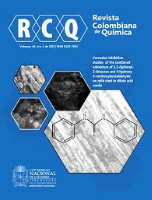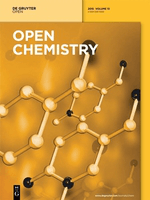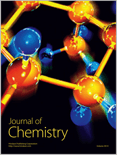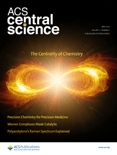
Revista Colombiana de Quimica
Scope & Guideline
Fostering Collaboration in Chemical Research.
Introduction
Aims and Scopes
- Environmental Chemistry:
Research that addresses the impact of chemicals on the environment, including studies on pollutants, toxic substances, and methods for remediation and sustainability. - Nanotechnology and Materials Science:
Innovative studies involving nanomaterials, their synthesis, characterization, and applications in various fields such as sensors, drug delivery, and catalysis. - Biochemistry and Biotechnology:
Exploration of biochemical processes and the development of biotechnological applications, including biosynthesis, antimicrobial properties, and drug development. - Analytical Chemistry:
Advancements in analytical techniques for the detection and quantification of chemical substances, emphasizing methodologies such as spectroscopy, chromatography, and electrochemical sensors. - Computational Chemistry:
Utilization of computational methods to model and simulate chemical interactions, providing insights into molecular behavior and aiding in the design of new compounds.
Trending and Emerging
- Sustainable Chemistry and Green Technologies:
There is an increasing emphasis on sustainable practices, including the development of eco-friendly materials and processes that minimize environmental impact, such as the use of biopolymers and waste recycling. - Advanced Drug Delivery Systems:
Research focusing on innovative drug delivery methods, particularly using nanomaterials and biocompatible systems, is gaining traction due to the growing demand for targeted therapies and effective pharmaceutical solutions. - Computational and Theoretical Chemistry:
The use of computational techniques to study chemical phenomena is on the rise, with researchers applying simulations to predict molecular behavior, optimize reactions, and understand complex systems. - Nanomedicine and Antimicrobial Applications:
Emerging themes in nanomedicine, particularly the use of nanoparticles for therapeutic purposes and their effectiveness against various pathogens, reflect a significant trend in addressing health challenges. - Wastewater Treatment and Environmental Remediation:
Research that integrates chemistry with environmental science to develop new methods for treating wastewater and removing contaminants is increasingly prominent, highlighting the journal's commitment to addressing global environmental issues.
Declining or Waning
- Traditional Organic Synthesis:
Research focused solely on classical organic synthesis techniques has become less prominent, as there is a growing trend towards more innovative and efficient synthetic methodologies that incorporate green chemistry principles. - Generalized Chemical Education:
Papers focused on basic chemical education and pedagogy are appearing less frequently, suggesting a shift towards more specialized and advanced topics that align with current research challenges. - Inorganic Chemistry without Application Context:
Studies in pure inorganic chemistry that do not connect with practical applications or interdisciplinary approaches are not being prioritized, as researchers tend to focus on applications that address real-world problems.
Similar Journals

Open Chemistry
Connecting Researchers with Open Access ChemistryOpen Chemistry, published by DE GRUYTER POLAND SP Z O O, is a distinguished peer-reviewed journal that has been serving the global chemistry community since its inception. With an ISSN of 2391-5420 and an E-ISSN also of 2391-5420, this open-access journal has been accessible to researchers and practitioners alike since 2015, ensuring a wide dissemination of high-quality research findings. Located in Germany, specifically at BOGUMILA ZUGA 32A STR, 01-811 WARSAW, MAZOVIA, POLAND, Open Chemistry aims to publish innovative research across various chemical disciplines, with special attention to miscellaneous chemistry and materials chemistry. It is currently ranked in the Q3 category for both fields as of 2023, reflecting its solid standing within the academic community, with specific ranks of 187/408 in General Chemistry and 153/317 in Materials Chemistry, corresponding to respective percentiles of 54 and 51. Open Chemistry not only enhances the accessibility of cutting-edge research but also serves as a vital resource for students, professionals, and scholars seeking to advance their knowledge in the rapidly evolving landscape of chemical sciences.

Journal of Chemistry
Advancing the Frontiers of Chemical KnowledgeJournal of Chemistry, published by Hindawi Ltd, serves as a critical platform for advancing knowledge in the field of chemistry, particularly in its miscellaneous sub-disciplines. With an impressive 2023 Scopus Rank of #123 out of 408 and positioned in the Q2 quartile, this journal exemplifies a robust academic rigor that appeals to researchers, professionals, and students alike. It features articles related to innovative chemical research and developments, catering to a diverse audience eager to contribute to the growing body of literature in the chemical sciences. The journal has been operational from 2013 to 2024, and its Open Access model ensures that findings are easily accessible to a global audience, fostering collaboration and knowledge sharing. With a commitment to quality and relevance, the Journal of Chemistry continues to play a significant role in shaping contemporary chemical research and education.

Canadian Journal of Chemistry
Advancing Chemistry Through Innovative ResearchWelcome to the Canadian Journal of Chemistry, a prominent publication dedicated to advancing the study of chemistry through original research and critical reviews. Published by Canadian Science Publishing, this journal has been a cornerstone of chemical research since its inception, covering a broad spectrum of topics within the field, including catalysis, organic chemistry, and general chemistry. With an ISSN of 0008-4042 and E-ISSN of 1480-3291, it provides a vital platform for researchers, professionals, and students to disseminate their findings and engage in scholarly discourse. Impact Factor is currently in development, with the journal classified in the Q4 category for catalysis and Q3 for miscellaneous chemistry fields, signifying its evolving contributions to the scientific community. The journal operates without an open access model, which ensures a rigorous peer-review process while maintaining subscription access for institutions and libraries. Located in Ottawa, Canada, the Canadian Journal of Chemistry continues to provide an invaluable resource for those dedicated to the scientific pursuit of chemistry, making significant strides in fostering interdisciplinary approaches and innovative research methodologies.

ACS Central Science
Elevating Chemistry with Open Access InsightsACS Central Science is a prestigious, peer-reviewed journal published by the American Chemical Society, focusing on innovative research across the diverse landscape of chemistry and chemical engineering. Established in 2015 as an Open Access platform, it has rapidly risen in prominence, achieving a remarkable Q1 ranking in both Chemical Engineering and Chemistry fields, with an impressive Scopus percentile of 98th and 96th respectively. This journal serves as a vital resource for researchers, professionals, and students seeking to disseminate and access cutting-edge advancements in these disciplines. By removing the barriers to access, ACS Central Science promotes the exchange of ideas and fosters collaborative research, ensuring that high-quality, impactful findings are available to all. With its clean and modern online interface, accessible from the heart of Washington, DC, the journal continues to attract leading scholars while influencing the trajectory of chemical sciences well into the future.

REVUE ROUMAINE DE CHIMIE
Exploring New Frontiers in Chemical ScienceREVUE ROUMAINE DE CHIMIE is a distinguished academic journal in the field of chemistry, published by EDITURA ACAD ROMANE in Romania. With an ISSN of 0035-3930, this journal has been a valuable platform for disseminating original research and insights in the diverse realm of chemistry since its inception. The journal currently operates under a competitive tier, categorized in Q4 for miscellaneous chemistry fields, as reflected in its Scopus ranking of #348 out of 408, placing it within the 14th percentile. Aiming to foster scientific discourse and innovation, the REVUE ROUMAINE DE CHIMIE provides a repository of knowledge that is crucial for researchers, professionals, and students eager to advance their understanding and contribute to the global chemistry community. By bridging local and international research initiatives, this journal plays an essential role in enhancing the visibility of Romanian scientific contributions on the world stage.

ANALYTICAL AND BIOANALYTICAL CHEMISTRY
Pioneering Innovative Research in ChemistryANALYTICAL AND BIOANALYTICAL CHEMISTRY, published by SPRINGER HEIDELBERG, is a leading international journal that serves as a vital platform for innovative research in the fields of analytical and bioanalytical chemistry. With an impressive impact factor and ranking in the Q2 category for both Analytical Chemistry and Biochemistry, the journal highlights key advancements and methodologies that drive the discipline forward. Established in 1996 and continuing vigorously into 2024, it has gained significant recognition with Scopus rankings placing it in the 83rd and 78th percentiles within its categories, underscoring its impact and relevance. The journal's commitment to open access facilitates widespread dissemination of critical scientific knowledge, making it an essential resource for researchers, professionals, and students dedicated to exploring the complexities of chemical analysis. With its base in Heidelberg, Germany, ANALYTICAL AND BIOANALYTICAL CHEMISTRY continues to inspire and influence the global research community.

Moroccan Journal of Chemistry
Advancing Chemistry Knowledge, One Article at a Time.Moroccan Journal of Chemistry, published by the University Mohammed Premier Oujda, serves as a pivotal platform for researchers and professionals in the field of chemistry, particularly focusing on diverse and emerging areas within the discipline. Established in 2018, this open-access journal facilitates widespread dissemination of scholarly articles, ensuring that cutting-edge research reaches a global audience. With an ISSN of 2351-812X and categorized in the Q3 quartile for miscellaneous chemistry in 2023, the journal maintains rigorous peer-review standards while fostering an inclusive environment for scientific dialogue. Located in Morocco, it aims to bridge local and international research communities, contributing to the advancement of knowledge in chemistry. As it continues to grow, the Moroccan Journal of Chemistry remains an essential resource for students, educators, and professionals eager to stay abreast of the latest developments in the field.

SOUTH AFRICAN JOURNAL OF CHEMISTRY-SUID-AFRIKAANSE TYDSKRIF VIR CHEMIE
Empowering Chemical Knowledge for a Global CommunitySouth African Journal of Chemistry (Suid-Afrikaanse Tydskrif vir Chemie), published by Bureau Scientific Publications, is a pivotal open-access journal that has been disseminating groundbreaking research in the field of chemistry since its inception in 1996. With an ISSN of 0379-4350 and an E-ISSN of 1996-840X, this journal serves as a vital platform for researchers and professionals seeking to share their work and engage with the global chemistry community. Recognized for its significant contributions, the journal holds a Q3 quartile ranking in the miscellaneous chemistry category as of 2023 and ranks #216 out of 408 in General Chemistry according to Scopus. The South African Journal of Chemistry is dedicated to advancing knowledge in the discipline by publishing a wide array of articles, reviews, and studies that address pertinent chemical research and applications. With open access options available since 2000, it fosters a collaborative environment, ensuring that research is accessible to all, thereby enhancing the visibility and impact of chemists' work across South Africa and beyond.

Studia Universitatis Babes-Bolyai Chemia
Uniting Researchers for a Brighter Chemical FutureStudia Universitatis Babes-Bolyai Chemia, published by UNIV BABES-BOLYAI in Romania, serves as a pivotal platform for the dissemination of innovative research in the field of chemistry. With an ISSN of 1224-7154, this journal has been actively publishing since 2009 and aims to foster scientific collaboration and knowledge sharing among researchers, professionals, and students alike. Although currently categorized in Q4 of the Chemistry (miscellaneous) field, the journal provides an essential venue for emerging studies that contribute to the diverse landscape of chemical research. With its commitment to accessibility and scholarly discourse, Studia Universitatis Babes-Bolyai Chemia remains an important resource for those seeking to stay abreast of the latest developments and trends in general chemistry, holding a Scopus rank within the lower quartiles. Researchers and practitioners are encouraged to engage with its content to enrich their own work and to aid in the advancement of the scientific community.

EGYPTIAN JOURNAL OF CHEMISTRY
Empowering Researchers with Cutting-Edge Chemical KnowledgeThe Egyptian Journal of Chemistry, published by the National Information & Documentation Centre (NIDOC), serves as a vital platform for disseminating novel research and advancements in the field of chemistry and its interdisciplinary applications. Established in 2004 and continuing its publication through 2024, this journal encapsulates a diverse range of topics including Biochemistry, Chemical Engineering, and Materials Science, reflected in its respectable Scopus rankings. With an array of Quartile rankings indicating its varying impact across different categories, scholars can benefit from its insights into innovative solutions and methodologies that address pressing scientific challenges. Although it currently does not operate under an open access model, researchers and students are encouraged to leverage its findings as it plays a pivotal role in the academic landscape of Egypt and beyond. For those engaged in chemical research, the Egyptian Journal of Chemistry stands as an essential resource, contributing significantly to the global body of scientific knowledge.